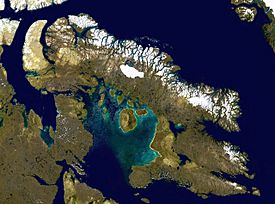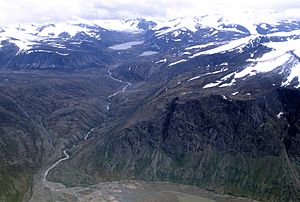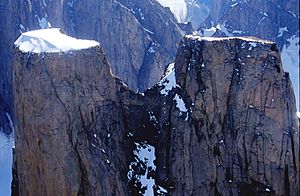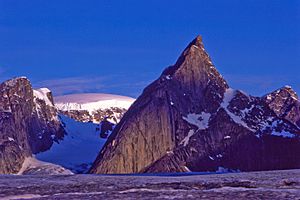Baffin Mountains facts for kids
Quick facts for kids Baffin Mountains |
|
|---|---|
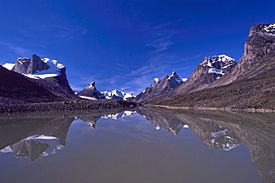
Summit Lake, mountains, Auyuittuq National Park
|
|
| Highest point | |
| Peak | Mount Odin |
| Elevation | 2,147 m (7,044 ft) |
| Geography | |
| Country | Canada |
| Parent range | Arctic Cordillera |
The Baffin Mountains are a long chain of mountains. They are found along the northeastern coast of Baffin Island and Bylot Island in Nunavut, Canada. These mountains are part of a much larger system called the Arctic Cordillera.
These ice-covered mountains are some of the tallest peaks in eastern North America. They reach heights of about 1,525 to 2,146 meters (5,000 to 7,040 feet) above sea level. Even though they are separated by water, they are closely linked to other mountain ranges in the larger Arctic Cordillera.
Contents
What are the Baffin Mountains like?
The highest point in the Baffin Mountains is Mount Odin, standing at 2,147 meters (7,044 feet) tall. Mount Asgard, at 2,015 meters (6,611 feet), is probably the most famous peak. In the northern part of the Baffin Mountains, the tallest point is Qiajivik Mountain, which is 1,963 meters (6,440 feet) high.
You won't find any trees in the Baffin Mountains. This is because they are located north of the Arctic tree line, where it's too cold for trees to grow. The rocks that make up these mountains are mostly granite. This type of rock is very hard and has been deeply shaped by nature.
The area was covered in ice until about 1,500 years ago. Large parts of the mountains are still covered in ice today. From a geological point of view, the Baffin Mountains form the eastern edge of the Canadian Shield. This is a huge area of ancient rock that covers much of Canada.
Tallest Peaks of the Baffin Mountains
Here is a list of some of the highest mountains in the Baffin range:
| Rank | Name | Meters (m) | Feet (ft) |
|---|---|---|---|
| 1 | Mount Odin | 2147 | 7044 |
| 2 | Mount Asgard | 2015 | 6611 |
| 3 | Qiajivik Mountain | 1963 | 6440 |
| 4 | Angilaaq Mountain | 1951 | 6401 |
| 5 | Kisimngiuqtuq Peak | 1905 | 6250 |
| 6 | Ukpik Peak | 1809 | 5935 |
| 7 | Bastille Peak | 1733 | 5686 |
| 8 | Mount Thule | 1711 | 5614 |
| 9 | Angna Mountain | 1710 | 5610 |
| 10 | Mount Thor | 1675 | 5495 |
Ice and Glaciers in the Baffin Mountains
Deep fjords (long, narrow inlets of the sea with steep sides) and valleys separate the mountain ranges. These valleys were carved out by glaciers. Many of the mountains are covered in ice. The Baffin Mountains do not get a lot of snow. They receive much less snow than places like the Saint Elias Mountains in Alaska and Yukon.
The biggest ice cap (a large dome-shaped mass of ice) in the Baffin Mountains is the Penny Ice Cap. It covers an area of about 6,000 square kilometers (2,300 square miles). In the mid-1990s, Canadian scientists studied this ice cap. They drilled into the ice to take samples, called ice cores. These cores helped them learn about how the glacier has frozen and thawed over hundreds of years.
Plants and Animals of the Baffin Mountains
The main types of plants in the Baffin Mountains are mosses and lichens. You can also find tough, cold-hardy vascular plants. These are plants that have special tissues to carry water and nutrients. Examples include sedge and cottongrass. These plants grow in patches across the landscape.
A Look at the History of the Baffin Mountains
One of the first climbing trips in the Baffin Mountains happened in 1934. A team led by J.M. Wordie climbed two peaks called Pioneer Peak and Longstaff Tower.
Auyuittuq National Park was created in 1976. This park protects a large area of Arctic wilderness. It includes fjords, glaciers, and huge ice fields. In Inuktitut, the language of the Inuit people of Nunavut, Auyuittuq means "the land that never melts." Auyuittuq started as a national park reserve in 1976. It became a full national park in 2000.
Inuit people lived in the Baffin Mountains long before Europeans arrived. It is thought that Norsemen (Vikings) were the first Europeans to visit in the 11th century. However, the first recorded sighting of Baffin Island by a European was by Martin Frobisher in 1576. He was searching for the Northwest Passage, a sea route through the Arctic.
See also
 In Spanish: Montes Baffin para niños
In Spanish: Montes Baffin para niños


